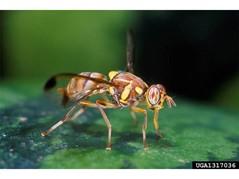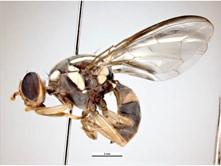Fruit flies are the world's most destructive fruit pests. Many species of fruit fly do not exist in Australia. If they get in, they could cause major disruption to our trade in horticultural products.
Australia’s horticultural production is valued at over $9 billion and employs over 60,000 people. Many crops are susceptible to attack by fruit flies.
Australia is at risk of invasion by exotic fruit fly. There have been repeated incursions and eradications in the Torres Strait.
The Torres Strait Exotic Fruit Fly Eradication Program is a seasonal program that targets 3 exotic fruit fly species.
Detection in Australia
There are no current detections of the 3 target exotic fruit flies on the Australian mainland.
Torres Strait is a small but important part of Australia and the state of Queensland. It’s close to New Guinea, which is a serious biosecurity risk to Australia. There is a native population of the target species in the Western Province of Papua New Guinea.
Exotic fruit fly species move into the Torres Strait seasonally. They move with the wind, vessel movements and unauthorised foreign fishing activity.
There are more than 150 native and 1 important introduced species of fruit fly in Australia. Only 2 of these species attack crops and cause economic damage. They are the native Queensland fruit fly (Bactrocera tryoni) and the introduced Mediterranean fruit fly (Ceratitis capitata). These 2 fruit flies are not the target of the eradication program.
Response program
The Torres Strait Exotic fruit fly eradication program targets 3 exotic fruit fly species:
- oriental fruit fly (Bactrocera dorsalis)
- melon fly (Zeugodacus cucurbitae)
- New Guinea fruit fly (B. trivialis)
The current $3.5 million response plan runs for 5 years from 2021 to 2026. It monitors and aims to eradicate the flies before they can establish in the Torres Strait. The plan includes:
- trapping and identifying fruit flies for early detection
- pheromone-based insecticide baits (blocks) to attract and kill male fruit flies
- protein-based insecticide bait (spray) to kill adult female flies
- movement restrictions on fruit and vegetables to prevent pest introduction and spread.
Program governance
The response program was endorsed under the national emergency response arrangements. It’s managed under the Emergency Plant Pest Response Deed. Costs are shared by the Australia, state and territory governments and industry.
The program is part of collaboration across northern Australia to protect our agricultural industries. Fruit fly monitoring in Torres Strait is also part of a national fruit fly trapping network. This provides early warning advice, which supports market access for our horticultural exports.
The Queensland Department of Agriculture and Fisheries (QDAF) leads the eradication program. The Northern Australia Quarantine Strategy (NAQS) provides operational and technical support.
Program forecast
Without a response program, we’d have an exotic fruit fly incursion in 12-18 months. This prediction is based on technical advice and trapping data.
A potential eradication cost would be higher than response program investment.
History of the program
Fruit fly response activities in the Torres Strait began in 1996. This came after an outbreak of oriental fruit fly (Asian papaya fruit fly) around Cairns in far north Queensland.
This response took four years and cost $33.5 million to eradicate the pest. The outbreak resulted in bans on exports of Australian horticultural products. The loss to farmers was estimated at $100 million.
This led to the Long-Term Containment Strategy for Exotic Fruit Flies in Torres Strait. This strategy was effective and beneficial to Australia. It became the National Exotic Fruit Fly in Torres Strait Eradication Program in 2015.
See more
How we coordinate a response to an outbreak.
Your obligations
Keep exotic dangerous pests and diseases out of Australia. Never ignore our strict biosecurity rules.
Report sightings
Report anything unusual, even if you’re not sure.
If you suspect exotic fruit fly, call the Exotic Plant Pest Hotline on 1800 084 881.
For signs of exotic pests and diseases in imported goods, sea containers or parcels, call See. Secure. Report on 1800 798 636 or use our online form.
Follow the rules
One of our biggest threats is travellers bringing infested fruits and vegetables into Australia. Non-commercial fruit and vegetable in baggage or hand luggage must be destroyed. Unless they have a valid import permit.
Imports of fruit and vegetables must be certified as grown in a fruit fly free country or region. If not, they are treated to kill maggots.
Import shipments may need to be treated and certified. Before you import, check our Biosecurity Import Conditions system (BICON).
Movement controls
If you live or travel in the Torres Strait or Far North Queensland be aware of restrictions on moving goods (agriculture.gov.au).
There are domestic quarantine restrictions in place. These prevent the spread of Queensland and Mediterranean fruit fly as well as exotic fruit fly.
Fruit and vegetables grown in affected areas must be treated for Queensland fruit fly. You must do this before you move them to another part of Australia.
Travellers must not take fruit and vegetables between states and territories.
Most states do not allow fruit to cross their border. Check the Interstate Quarantine website before you travel.
See Queensland restrictions on moving plant material, soil and equipment
About the pest
Female flies pierce the fruit’s skin to lay their eggs beneath the surface. This introduces bacteria that start the fruit rotting. The eggs develop into maggots that drink the rotting pulp.
Flies can grow from eggs to adults in about four to five weeks. The adults are about 7mm long and look like small wasps. Eggs are about 1–2 mm long and whitish. The maggots are creamy-white and about 12–20 mm long.
Fruit fly species can multiply rapidly and can spread over large distances. All our mainland states have climates and host crops suitable for exotic fruit fly.
Exotic, economic fruit fly are listed as number 4 in the Top 42 National Priority Plant Pests.
Oriental fruit fly (Bactrocera dorsalis)
Oriental fruit flyis highly invasive and one of the most damaging pests of tropical horticulture in the world. It can affect over 490 fruit and vegetables. These include avocado, banana, bean, capsicum, cashew, cherry, coffee, cucumber, eggplant, grapefruit, guava, lemon, lime, mandarin, mango, navel orange, papaya, peach, passionfruit and tomato.
This species is widespread in Africa, Asia and parts of the pacific. It is closest to Australia in Indonesia, Timor Leste and Papua New Guinea.
Previous outbreak
In the late 1990s, we had an outbreak of oriental fruit fly (then known as papaya fruit fly) in Queensland.
During the successful eradication process, it was found to breed in 35 host species. The outbreak damaged fruit crops including coffee berries and green papaya/papaw.
See more on Oriental fruit fly (Business Queensland).

Melon fly (Zeugodacus cucurbitae)
Melon fly is a serious pest of cucurbit crops. It can also affect crops such as avocado, bean, cherry, cowpeas, guava, lychee, navel orange, papaya, passionfruit and tomato.
Melon fly is widespread in Asia, sub-Saharan Africa and in the Pacific (Hawaii, Guam, Kiribati, Nauru, Northern Mariana Islands, and the Solomon Islands).
Like most of its species, melon fly multiplies fast and can spread over large distances. Melon fly would cause serious damage to horticultural industries if it established here.
Many countries have trade restrictions on produce from regions that have melon fly. Growers would likely face difficulties exporting their produce due to these restrictions.
See more on melon fruit fly (Business Queensland).

See more images of Melon fly on the PaDIL website.
New Guinea fruit fly (Bactrocera trivialis)
New Guinea fruit fly is a major pest of horticultural crop. It targets mango, chilli, citrus, guava and peach. This fly is found in Papua New Guinea and Indonesia.
Find out more about New Guinea fruit fly (Business Queensland).

Resources
See more on fruit flies, response activities and biosecurity in northern Australia.
- Fruit flies(Plant Health Australia)
- Exotic fruit flies (agriculture.gov.au)
- Northern Quarantine Strategy (NAQS) (agriculture.gov.au)
- Fruit flies in Australia (agriculture.gov.au)
- Fruit Fly ID Australia (fruitflyidentification.org.au)
- Exotic fruit fly surveillance (QLD Department of Agriculture and Fisheries)
- Fruit fly in South Australia (SA Department of Primary Industries and Regions)
- Northern biosecurity(agriculture.gov.au)
- Northern Australia Biosecurity Strategy 2020 – 2030 (agriculture.gov.au)